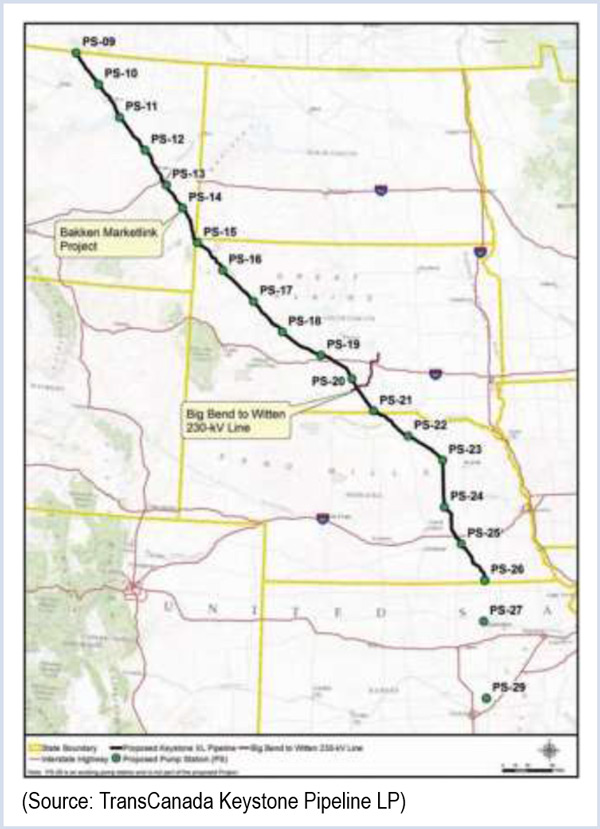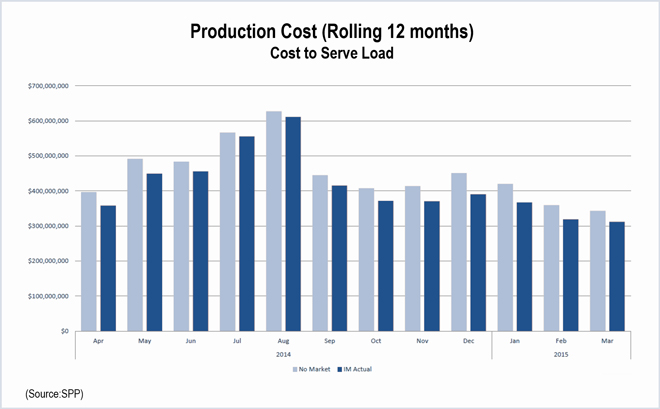SPP said its integrated marketplace produced net savings of about $210 million in the first year after combining 16 balancing authorities into the marketplace.
Over the rolling 12-month period ending in March, the market produced gross benefits of $430 million, or $210 million after accounting for $170 million in historical savings and $50 million in annual cost. That analysis excludes March 2013, the first month of the transition, when the RTO operated with higher unit commitments than required.
SPP-MISO Market-to-Market Showing Results
SPP’s market-to-market initiative with MISO, which began last month, is paying dividends, SPP’s Bruce Rew told members. Rew said there was activity on all but two days in March, with daily settlements ranging from $2,000 to more than $1 million.
Rew said the two RTOs are working to address “oscillation” at some locations, where congestion returns almost immediately after being relieved.
“It’s working,” he said. “It needs some improvements and we’re working closely with MISO to do that.”
Proposal on Disqualifying Regulation Resources Remanded
The Markets & Operations Policy Committee remanded Revision Request 33 to the Market Working Group. The request would allow SPP to disqualify resources from participation in the regulation market for poor performance.
Bill Grant of Southwest Public Service Co. said he was concerned that the rule was overly strict and that its requirement that resources respond within four seconds would result in the unnecessary disqualification of many resources.
“You’re already financially incented to respond. So we’re questioning the need for disqualification altogether,” he said. “… If we’re going to start disqualifying people over four-second deployments, people need to understand that because most people’s [energy management system] might not respond in four seconds.”
Staff said SPP’s intent is to improve the response of the poorest-performing “outliers.” Staffers said they have never disqualified a resource.
Members approved RR44 and RR45, which add details on how SPP calculates regulation resources’ actual mileage for settlement purposes.
Members OK Short-Term Unit Commitment Study
Members approved RR49, which would create a short-term reliability unit commitment (RUC) study as part of the intra-day RUC process. The study will provide results for 15-minute intervals, allowing operators to make unit commitments with more granularity than the current one-hour study. It is expected to reduce the number of real-time manual commitments.
Delays on Z2 Credit Fix Spark Frustration
Members expressed frustration with SPP’s slow progress in creating a process for properly crediting and billing transmission customers for system upgrades under Tariff attachment Z2. Repeated delays in the project led SPP to reorganize the staff team handling it. SPP’s software vendor is now projecting completion of the project by June 2016.
The project has proven more complex than originally expected because of the need to avoid over-compensating project sponsors, and to include a way to “claw back” revenues from members who owe SPP money for other reasons. Accounting for transfers of reservations has also proven a challenge.
“I have been dealing with this issue for so many years,” said Steve Gaw, representing The Wind Coalition. “I don’t know how many years ago we were being told that it would be fixed ‘next quarter.’
“I don’t have any more faith in the dates,” he continued. “I just don’t know when there’s going to be accountability [to the] folks who have been owed money for all of this time.”
Monroe acknowledged the frustration. “We’re playing with the hand we’ve been dealt,” he said.
2016 ITPNT Scope Approved
MOPC approved the scope of the 2016 Integrated Transmission Planning Near-Term (ITPNT), including the automatic recommendation of the notices to construct from the Consolidated Balancing Authority scenario.
The 2016 ITPNT’s primary focus is to identify solutions required to address potential reliability problems under normal conditions (no contingency) and (N-1) scenarios. It will include modeling of the system through 2020.
It will also reflect improved dispatch of wind resources and include the Integrated System — the Western Area Power Administration Upper Great Plains, Basin Electric Power Cooperative and Heartland Consumers Power District — as SPP members. (See Spurned by Entergy, SPP Expands in Great Plains.)
Keystone Pipeline Would Add SPP Loads

Caspary said those loads, in addition to unserved loads in New Mexico and Kansas, helped justify the Notices to Construct that SPP has issued.
Bary Warren of Empire District Electric said SPP should be wary of overestimating loads, saying that gas and oil producers have recently announced 30 to 50% cuts in capital spending due to falling oil prices.
“The projects are probably needed,” he said. “The question is when are they needed? Should they be competitively bid? … At what voltage?”
Charters Approved
The committee approved the charter of the newly formed Stakeholder Prioritization Task Force and approved a revised charter for the Transmission Planning Improvement Task Force with no substantive changes.
MOPC also approved a change in the charter of the Transmission Working Group, allowing an increase in its membership from 20 to 24. Two of the seats will be assigned to representatives of WAPA-UGP and Basin Electric. Existing SPP members will be able to apply for one of the additional two seats on the working group.
Chief Operating Officer Carl Monroe said other committees may see similar increases in their membership to accommodate the new members.
The new charter also updates the group’s scope to include:
- Changes to the SPP portion of North American Electric Reliability Corp. flowgates;
- Reviewing and developing rating criteria, including minimum design standards;
- Reviewing and approving study information for interconnections; and
- Reviewing technical and reliability aspects of all policies, business practices, study scopes, SPP criteria changes and tariff changes.
Regional Allocation Review Delayed
Members approved delaying the regional cost allocation review until new models are developed for the 2017 Integrated Transmission Plan 10-Year Assessment. This would delay completion of the RCAR II analysis until July 2016.
Members were concerned with proceeding with the models being used in the 2015 ITP10, which are about two years old and do not include Kansas City Power and Light’s January decision to stop burning coal at its Montrose power plant in Clinton. The company plans to close or convert one of its units to natural gas by 2016 and make similar decisions on the remaining two units by 2021.
SPP, which completed its last cost allocation review in 2013, is required to conduct such reviews every three years.
— Rich Heidorn Jr.




